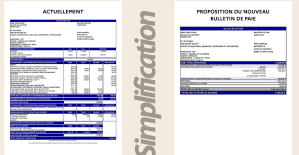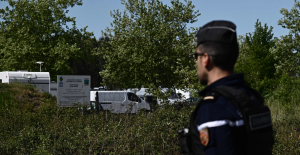there Are out there in the universe life? Giant telescopes are built to be an answer to this question, naturally, about the Extremely Large Telescope (ELT) the European southern Observatory with its 39-metre primary mirror of the James Webb space telescope, the "eye" will open at least 6.5 metres wide.
In comparison to these giants of Cheops appears to be rather modest. The primary mirror of the largely developed in Switzerland, the satellite has a diameter of only 33 centimeters. However, Cheops fulfilled an important task: The small Swiss satellite is preparing for the large telescopes of the way. He shows the future users of the ELT and the James Webb, the most interesting objects, on which you can focus the look of your giant eyes, at least when it comes to the study of potentially life-friendly exoplanet. Expected to Cheops is at 17. December on Board of a carrier rocket from the European spaceport in Kourou, French Guiana, in the space start.
"We thought:' If Switzerland wants to be in the astronomy continue to be at the forefront, you must make something New."Willy Benz, University of Bern
The first ideas to Cheops in 2008, when the Swiss national Fund was looking for new research areas. Willy Benz of the Department of space research and planetary Sciences of the University of Bern and the newly crowned Nobel prize winner, Didier Queloz, planned a feasibility study for a small Swiss satellite. "Switzerland had built the instruments with which Michel Mayor and Didier Queloz in 1995 with a ground-based telescope first exoplanet discovered," says Benz. "We thought:' If Switzerland wants to be in the astronomy continue to be at the forefront, you must make something New." The idea was to leave the ground and to develop a satellite for the characterization of exoplanets, the "Characterising Exoplanets Satellite," as Cheops means in detail.
feasibility study for the Swiss planet hunters
The research focus of the national Fund of the Bernese astronomers got. But at least they were able to win some of the partners – the Federal office for education, research and Innovation, the aerospace company Ruag, as well as the Space Center at the EPFL in Lausanne for your concern and in this way, in 2010 the feasibility study. The result: For Switzerland, this is the only space project would cost in the range of 100 million Swiss francs to be expensive. The idea of a Swiss planet hunter seemed to have died.
Soon, however, a glimmer of hope appeared. Like Willy Benz reported, was at that time in the scientific Advisory Board of the European space Agency (ESA), which he directed for himself, to discuss whether we should also promote smaller missions. Previously, the ESAS financed only medium-sized missions, with totals in the range of 500 million euros, as well as the very large, multibillion-dollar L-missions, of which only an average of one per decade to be realized. "Minor missions, the S-class would also allow countries such as Switzerland, the missions leader to lead," says Benz. This concern was given the green light. In the spring of 2012, ESA wrote to the first S-class missions that should be supported with 50 million euros.
"Because it has made us click," says Benz. "Hurry, we have rewritten the feasibility study in a project proposal." In order to increase the prospect of success, had to Benz to convince, however, many other countries, the Cheops project. Finally, Switzerland has only one vote in the programme Committee of the ESA. This has been achieved. The Bernese astronomers were able to forge a consortium of eleven countries. "In June 2012, we have submitted the project proposal." The 290-pound, 2.6-metre-high great pyramid of Khufu was selected as the first S-class Mission of the ESA from 26 submitted projects.
Supported by the University of Geneva, have planned the astronomers of the University of Bern, the telescope is then in the Detail. Of the 100 million Swiss francs of which Switzerland contributed 33 million. A variety of Swiss industry partners established the structure of Cheops. Italy has built the optics, Germany the electronics, Spain, the antenna for the data, Hungary, the radiators, other countries and the ground segment.
extremely precise brightness measurements
"The great art was to develop an optical System, the extremely precise brightness measurements allowed," says Benz. After various Tests Cheops in October was by air freight to the European spaceport in French Guiana, transported. About two and a half hours, the satellite will be in need of until he has reached after the Start of his Position in the 700-km altitude. In the course of two months, the device is driven after the other and tested. "From the middle of March, there is real science," says Benz.
From its orbit, from Cheops to measure the brightness of stars and to the so-called transit watch: Pushes a Planet on its orbit in front of its parent star, makes it a little star light. The brightness of the star decreases from the point of view of the satellite, temporarily minimal, in the case of a planet the Size of earth, typically a ten-thousandths. These tiny changes in Brightness should be measured Cheops. "From earth, so precise measurements are not possible, because the atmosphere to strong fluctuations caused," says Benz.
satellite parts are mounted. Photo: ESA
Registers the camera of Cheops in the case of a Transit, a light acceptance, can the Size of the planet can be derived. Because the bigger the Planet, the more starlight it covers. For this reason, the astronomers will align the great pyramid of Khufu to a few Hundred stars for which exoplanets are detected. Other observations provide further information: Circling a Planet around a star, he brings these easy to roll, what colour changes in the star's light causes. The stronger the color shift, the harder the Planet. With this so-called Doppler method, the Nobel prize-winner Michel Mayor and Didier Queloz in 1995 discovered the first exoplanet.
Target level is the average density of the planet
When, thanks to Cheops, the Size, and by means of the Doppler method, the mass is known, can be obtained from the actual target size can be derived: the mean density of the planet. Which in turn provides information about the characteristic: it Is a dense rocky planet like earth or Mars, an oceanic planet, probably the exoplanets GJ 1214 b, or an airy, gaseous planets like Jupiter? Especially rocky planets in the right distance from the mother star are eligible for the development of life.
Through the characterization of already-known exoplanets, Cheops can make it so those items have been located, which are suitable for further studies at the best, such as from 2021, with the James Webb space telescope, the successor of Hubble, and 2026 with the gigantic ELT. These and other future telescopes can study the atmosphere of exoplanets, and possibly traces of life can identify with.
Events at the Start of Cheops:cheops.unibe.ch/launch
Created: 04.12.2019, 19:08 PM

 His body naturally produces alcohol, he is acquitted after a drunk driving conviction
His body naturally produces alcohol, he is acquitted after a drunk driving conviction Who is David Pecker, the first key witness in Donald Trump's trial?
Who is David Pecker, the first key witness in Donald Trump's trial? What does the law on the expulsion of migrants to Rwanda adopted by the British Parliament contain?
What does the law on the expulsion of migrants to Rwanda adopted by the British Parliament contain? The shadow of Chinese espionage hangs over Westminster
The shadow of Chinese espionage hangs over Westminster Colorectal cancer: what to watch out for in those under 50
Colorectal cancer: what to watch out for in those under 50 H5N1 virus: traces detected in pasteurized milk in the United States
H5N1 virus: traces detected in pasteurized milk in the United States What High Blood Pressure Does to Your Body (And Why It Should Be Treated)
What High Blood Pressure Does to Your Body (And Why It Should Be Treated) Vaccination in France has progressed in 2023, rejoices Public Health France
Vaccination in France has progressed in 2023, rejoices Public Health France The right deplores a “dismal agreement” on the end of careers at the SNCF
The right deplores a “dismal agreement” on the end of careers at the SNCF The United States pushes TikTok towards the exit
The United States pushes TikTok towards the exit Air traffic controllers strike: 75% of flights canceled at Orly on Thursday, 65% at Roissy and Marseille
Air traffic controllers strike: 75% of flights canceled at Orly on Thursday, 65% at Roissy and Marseille This is what your pay slip could look like tomorrow according to Bruno Le Maire
This is what your pay slip could look like tomorrow according to Bruno Le Maire Sky Dome 2123, Challengers, Back to Black... Films to watch or avoid this week
Sky Dome 2123, Challengers, Back to Black... Films to watch or avoid this week The standoff between the organizers of Vieilles Charrues and the elected officials of Carhaix threatens the festival
The standoff between the organizers of Vieilles Charrues and the elected officials of Carhaix threatens the festival Strasbourg inaugurates a year of celebrations and debates as World Book Capital
Strasbourg inaugurates a year of celebrations and debates as World Book Capital Kendji Girac is “out of the woods” after his gunshot wound to the chest
Kendji Girac is “out of the woods” after his gunshot wound to the chest Skoda Kodiaq 2024: a 'beast' plug-in hybrid SUV
Skoda Kodiaq 2024: a 'beast' plug-in hybrid SUV Tesla launches a new Model Y with 600 km of autonomy at a "more accessible price"
Tesla launches a new Model Y with 600 km of autonomy at a "more accessible price" The 10 best-selling cars in March 2024 in Spain: sales fall due to Easter
The 10 best-selling cars in March 2024 in Spain: sales fall due to Easter A private jet company buys more than 100 flying cars
A private jet company buys more than 100 flying cars This is how housing prices have changed in Spain in the last decade
This is how housing prices have changed in Spain in the last decade The home mortgage firm drops 10% in January and interest soars to 3.46%
The home mortgage firm drops 10% in January and interest soars to 3.46% The jewel of the Rocío de Nagüeles urbanization: a dream villa in Marbella
The jewel of the Rocío de Nagüeles urbanization: a dream villa in Marbella Rental prices grow by 7.3% in February: where does it go up and where does it go down?
Rental prices grow by 7.3% in February: where does it go up and where does it go down? Europeans: “All those who claim that we don’t need Europe are liars”, criticizes Bayrou
Europeans: “All those who claim that we don’t need Europe are liars”, criticizes Bayrou With the promise of a “real burst of authority”, Gabriel Attal provokes the ire of the opposition
With the promise of a “real burst of authority”, Gabriel Attal provokes the ire of the opposition Europeans: the schedule of debates to follow between now and June 9
Europeans: the schedule of debates to follow between now and June 9 Europeans: “In France, there is a left and there is a right,” assures Bellamy
Europeans: “In France, there is a left and there is a right,” assures Bellamy These French cities that will boycott the World Cup in Qatar
These French cities that will boycott the World Cup in Qatar NBA: the Wolves escape against the Suns, Indiana unfolds and the Clippers defeated
NBA: the Wolves escape against the Suns, Indiana unfolds and the Clippers defeated Real Madrid: what position will Mbappé play? The answer is known
Real Madrid: what position will Mbappé play? The answer is known Cycling: Quintana will appear at the Giro
Cycling: Quintana will appear at the Giro Premier League: “The team has given up”, notes Mauricio Pochettino after Arsenal’s card
Premier League: “The team has given up”, notes Mauricio Pochettino after Arsenal’s card


















